Africa Wild Arachnid Book: Order Scorpiones (Scorpions)
Upload your picture of a scorpion and add a description underneath. Please only do one species per post.
All entries will be edited and updated (additional photos and information will be added by moderators). New entries will be posted according to taxonomic order and the post date does not reflect the actual date of new posts.
AW Arachnid Book: Scorpions - Photos & Descriptions
Moderator: Klipspringer
Re: Index to Africa Wild Insect & Invertebratae Books
 Index to Scorpions (Order Scorpiones)
Index to Scorpions (Order Scorpiones) Family: Buthidae (Fat-tailed Scorpions and Bark Scorpions)
Parabuthus granulatus Granulated Thick-tailed Scorpion viewtopic.php?f=247&t=3944&p=179462#p179462
Parabuthus raudus Thick-tailed Scorpion viewtopic.php?p=205007#p205007
Parabuthus villosus Black Hairy Thick-tailed Scorpion viewtopic.php?p=296611#p296611
Parabuthus transvaalicus Transvaal Thick-tailed Scorpion viewtopic.php?p=248716#p248716
Pseudolychas ochraceus Plain Pygmy Thicktail Scorpion viewtopic.php?p=532707#p532707
Uroplectes olivaceus Olive Bark Scorpion viewtopic.php?f=247&t=3944&p=179125#p179125
Uroplectes triangulifer Highveld Lesser-Thicktail viewtopic.php?p=503537#p503537
Family: Liochelidae
Opisthacanthus asper Tree Creeping Scorpion viewtopic.php?f=247&t=3944&p=179388#p179388
Family: Scorpionidae (Burrowing Scorpions or Pale-legged Scorpions
Opistophthalmus glabrifrons Shiny Burrowing Scorpion viewtopic.php?p=188936#p188936
Re: AW Arachnid Book: Scorpions - Photos & Descriptions
Olive Bark Scorpion Uroplectes olivaceus
Family: Buthidae
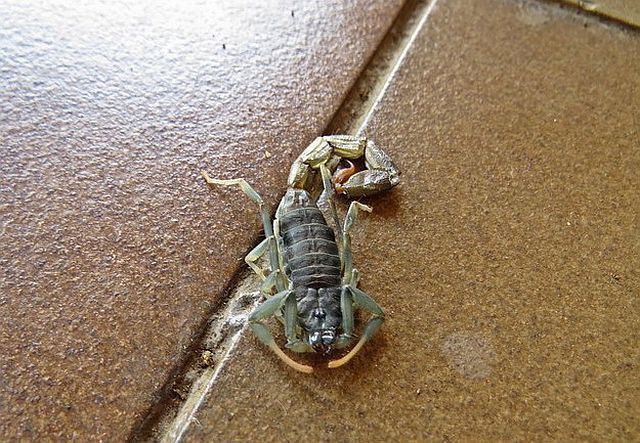 © Bushcraft
© Bushcraft
Kruger National Park, Satara
Description
A slender rapid moving scorpion, 60 mm in length, black or greenish colored, fine granulations on their tails. Charcterized by a subaculear tubercle. Females are more granular and have a very long broad basal pectinal tooth.
Habitat
Shelters under surface debris, loose bark, rock crevices.
It comes into lodges and houses and can be found in shoes and cloths.
Venom
Stings are painful. Their venom is not deadly to humans; however, it might cause some swelling.
Links: Jonathan Leeming: Scorpions of Southern Africa
Family: Buthidae
 © Bushcraft
© BushcraftKruger National Park, Satara
Description
A slender rapid moving scorpion, 60 mm in length, black or greenish colored, fine granulations on their tails. Charcterized by a subaculear tubercle. Females are more granular and have a very long broad basal pectinal tooth.
Habitat
Shelters under surface debris, loose bark, rock crevices.
It comes into lodges and houses and can be found in shoes and cloths.
Venom
Stings are painful. Their venom is not deadly to humans; however, it might cause some swelling.
Links: Jonathan Leeming: Scorpions of Southern Africa
Africa Wild Arachnid Book: Scorpions Liochelidae
Tree Creeping Scorpion Opisthacanthus asper
Family: Liochelidae
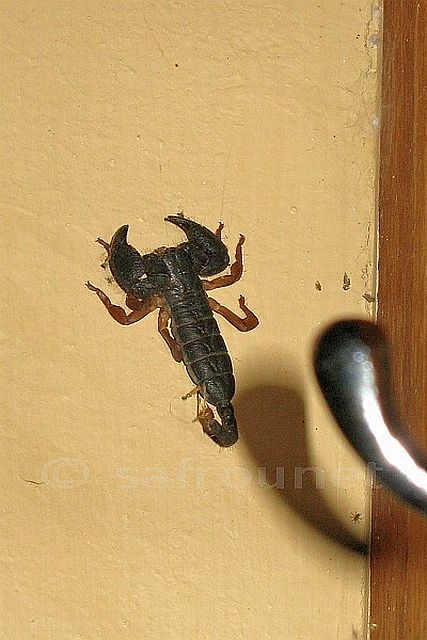 © nan
© nan
Satara Camp, Kruger National Park
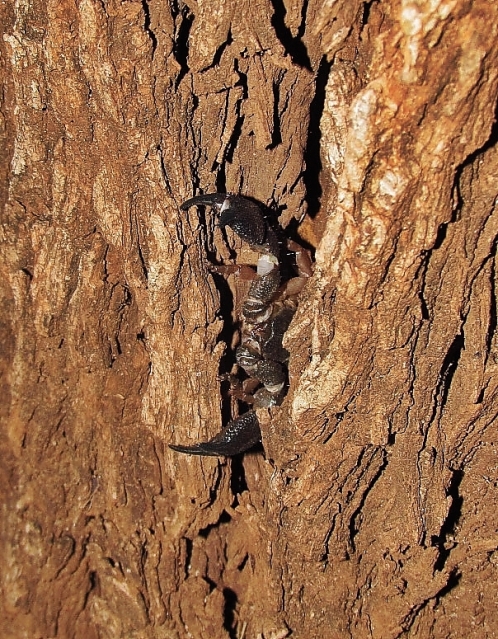 © Flutterby
© Flutterby
Lower Sabie Camp, Kruger National Park (April 2016)
Description
This species has a totally dark morph and a morph with lighter legs.
Distribution
Botswana, South Africa, Mozambique, Zimbabwe.
Habitat
Inhabits cracks in trees, under loose bark. Often found in Mopane and Knobthorn trees.
Very shy, rarely stings in defense.
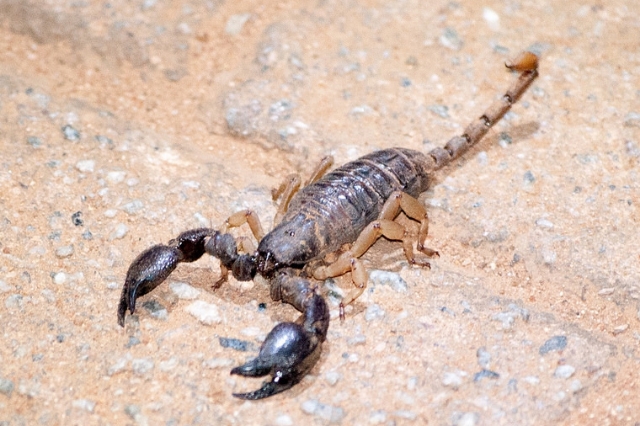 © steamtrainfan
© steamtrainfan
Berg-en-Dal Camp, Kruger National Park
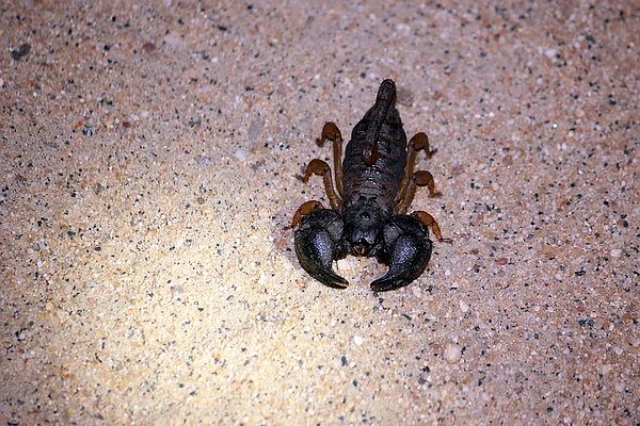 © Bushcraft
© Bushcraft
Talamati Camp, Kruger National Park
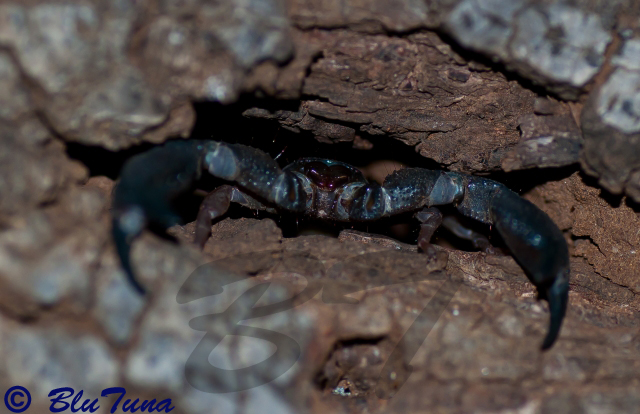 © BluTuna
© BluTuna
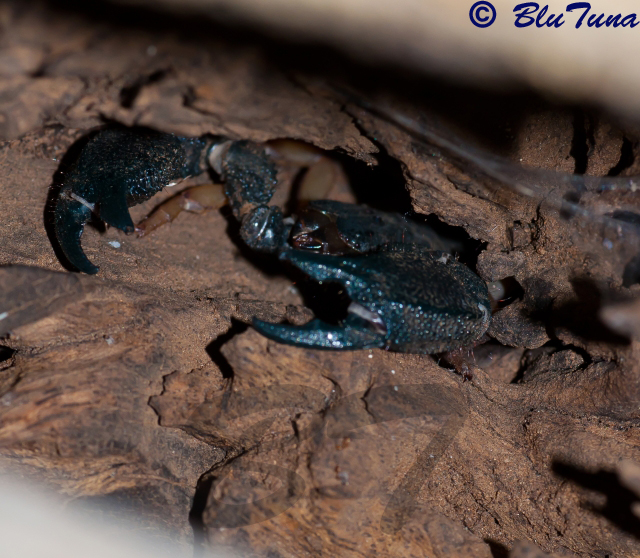 © BluTuna
© BluTuna
Kruger National Park, Balule camp
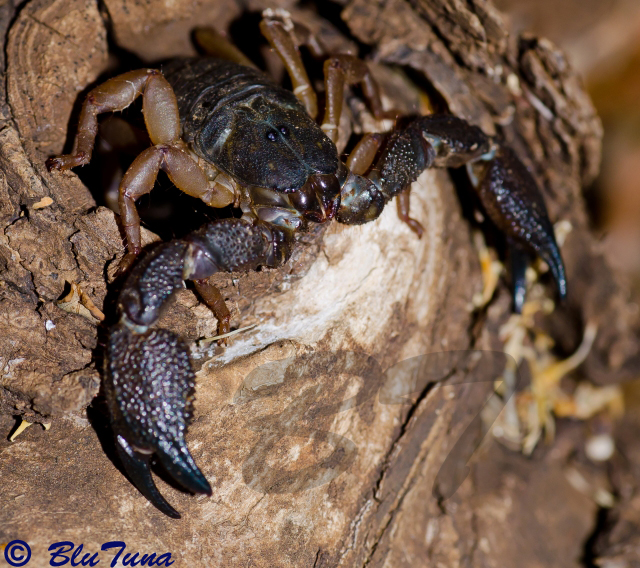 © BluTuna
© BluTuna
Kruger National Park, Balule camp
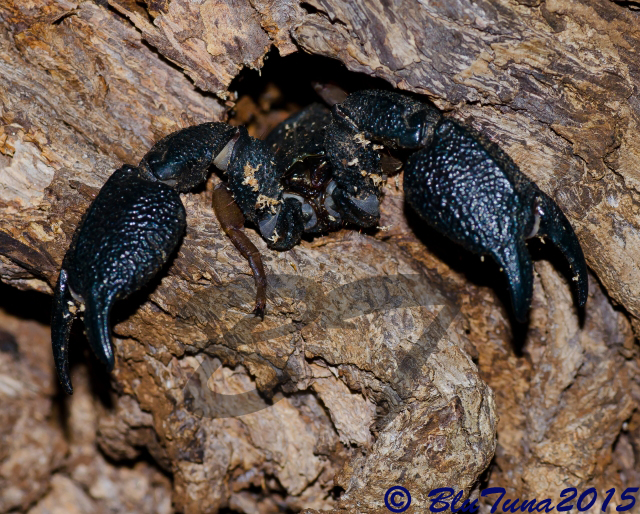 © BluTuna
© BluTuna
Kruger National Park, Crocodile Bridge camp
Family: Liochelidae
 © nan
© nanSatara Camp, Kruger National Park
 © Flutterby
© FlutterbyLower Sabie Camp, Kruger National Park (April 2016)
Description
This species has a totally dark morph and a morph with lighter legs.
Distribution
Botswana, South Africa, Mozambique, Zimbabwe.
Habitat
Inhabits cracks in trees, under loose bark. Often found in Mopane and Knobthorn trees.
Very shy, rarely stings in defense.
 © steamtrainfan
© steamtrainfanBerg-en-Dal Camp, Kruger National Park
 © Bushcraft
© BushcraftTalamati Camp, Kruger National Park
 © BluTuna
© BluTuna © BluTuna
© BluTunaKruger National Park, Balule camp
 © BluTuna
© BluTunaKruger National Park, Balule camp
 © BluTuna
© BluTunaKruger National Park, Crocodile Bridge camp
- nan
- Posts: 26307
- Joined: Thu May 31, 2012 9:41 pm
- Country: Switzerland
- Location: Central Europe
- Contact:
Re: AW Arachnid Book: Scorpions - Photos & Descriptions
Granulated Thick-tailed Scorpion Parabuthus granulatus
Family: Buthidae
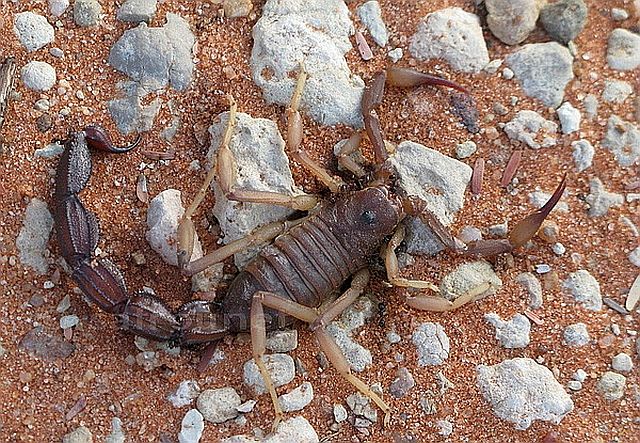
Twee Rivieren - Kgalagadi 16.1.2012
Description
Maximum size: 160 mm. Colouration variable shades of overall orange in the Kalahari Desert to blackish brown nearer the Orange River.
It has a relatively small vesicle compared to other species.
Distribution
It occurs from just north of Cape Town to northern Namibia and Angola, eastwards into the Northern Province and western Zimbabwe then southwards to the Eastern Cape but does not appear to be common, unlike other buthids that have a restricted range in which they are common.
Habitat
Parabuthus granulatus is found mainly in dry habitats (receiving less than 600 mm of rain per year). It digs a shallow burrow at the base of shrubs in sandy to consolidated sandy soils, but is also known to dig a shallow scrape under rocks in soil of widely variable hardness and texture. It may also be found in and around human dwellings in these areas.
Diet
It preys upon other scorpions and actively forages for prey as opposed to sitting and waiting. Travels far in search of food.
Reproduction
Shortly before birth, the female raises the front section of her body (stilting) with the pincers arched over the body and the pincers flexed. The first 2 pairs of legs form the birth basket where litters of over 30 are born in the summer months.
Venom
Watch out for this species, it will give you a nasty, painful bite and is the most medically important venomous scorpion in South Africa, with potentially life-threatening venom.
Links:
http://www.americanarachnology.org/JoA_ ... 1-0109.pdf
Family: Buthidae

Twee Rivieren - Kgalagadi 16.1.2012
Description
Maximum size: 160 mm. Colouration variable shades of overall orange in the Kalahari Desert to blackish brown nearer the Orange River.
It has a relatively small vesicle compared to other species.
Distribution
It occurs from just north of Cape Town to northern Namibia and Angola, eastwards into the Northern Province and western Zimbabwe then southwards to the Eastern Cape but does not appear to be common, unlike other buthids that have a restricted range in which they are common.
Habitat
Parabuthus granulatus is found mainly in dry habitats (receiving less than 600 mm of rain per year). It digs a shallow burrow at the base of shrubs in sandy to consolidated sandy soils, but is also known to dig a shallow scrape under rocks in soil of widely variable hardness and texture. It may also be found in and around human dwellings in these areas.
Diet
It preys upon other scorpions and actively forages for prey as opposed to sitting and waiting. Travels far in search of food.
Reproduction
Shortly before birth, the female raises the front section of her body (stilting) with the pincers arched over the body and the pincers flexed. The first 2 pairs of legs form the birth basket where litters of over 30 are born in the summer months.
Venom
Watch out for this species, it will give you a nasty, painful bite and is the most medically important venomous scorpion in South Africa, with potentially life-threatening venom.
Links:
http://www.americanarachnology.org/JoA_ ... 1-0109.pdf
Kgalagadi lover… for ever
https://safrounet.piwigo.com/
https://safrounet.piwigo.com/
Re: AW Arachnid Book: Scorpions - Photos & Descriptions
Shiny Burrowing Scorpion Opistophthalmus glabrifrons
Family: Scorpionidae
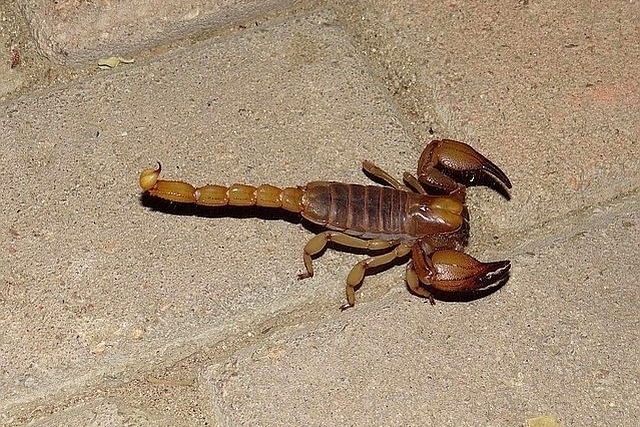 © Twigga
© Twigga
Kruger National Park, Tamboti ablutions
Description
This species is a medium-sized, have-built scorpion with large pedipalps. Varying color, but usually yellow-brown to rust-brown. The pedipalps, legs, metasoma (tail) and telson are lighter in color than trunk and the posterior part of the carapace. The adult size of this species is 9-11.5 cm. Males in this species have longer and thicker metasomas (tails) and a more elongated pedipalp hand.
This species are known to stridulate (making a hissing sound) loudly when disturbed. The sound is made when the scorpion is rubbing its chelicerae together.
The burrows of this scorpion are often constructed with a shallow scrape under a rock that leads to the burrow. The burrows vary from 10 mm to 1 metre deep, and can sometimes run to a lenght of 1.5 metres. The burroes often spural anticlockwise as they decend. Burrows in softer soil is usually shorter than burrows in harder soil. The mouthparts are used for breaking up the soil.
Distribution
Africa (Botswana, Mozambique, South Africa, Tanzania, Zimbabwe).
Habitat
This scorpion is known from dry areas with different temperature regimes (in areas with occational frost to areas with temperatures over 40 degrees). Its distrubution appears to be determined by soil hardness rather than soil type. Sandy soil seem to be avoided because this soild type makes it difficult to burrow.
Venom
Mildly venomous. This species will sting readilly, and has very powerful pincers which can pinch very painful.
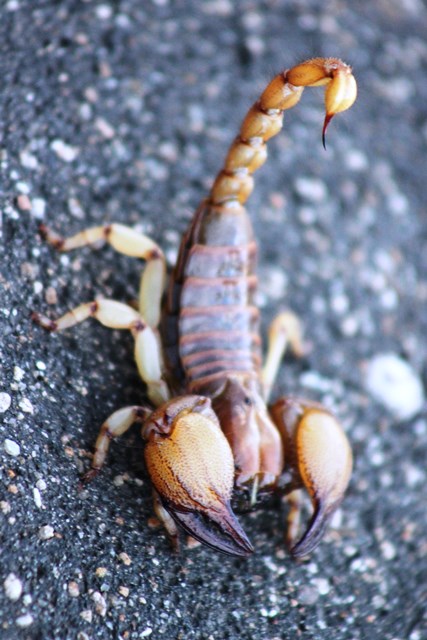 © Heksie
© Heksie
Scorpion in defensive stance, Kruger National Park
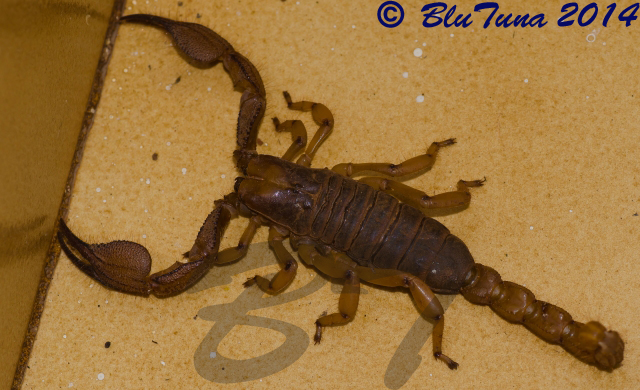 © BluTuna
© BluTuna
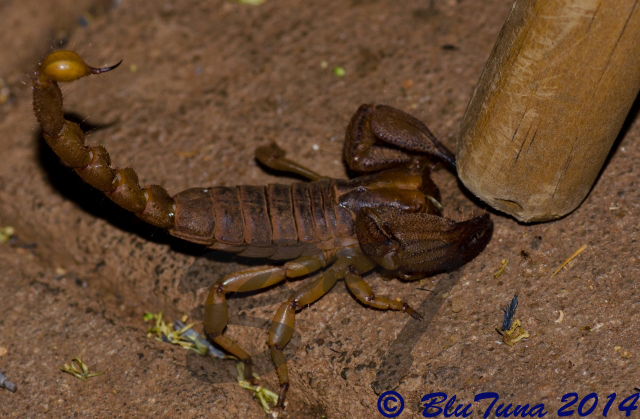 © BluTuna
© BluTuna
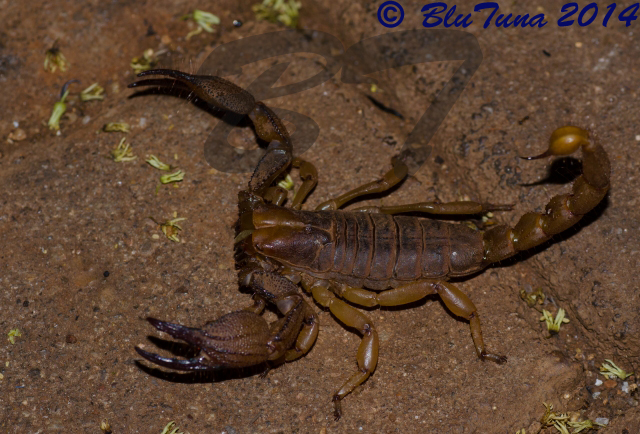 © BluTuna
© BluTuna
Kruger National Park, Crocodile Bridge camp
Family: Scorpionidae
 © Twigga
© TwiggaKruger National Park, Tamboti ablutions
Description
This species is a medium-sized, have-built scorpion with large pedipalps. Varying color, but usually yellow-brown to rust-brown. The pedipalps, legs, metasoma (tail) and telson are lighter in color than trunk and the posterior part of the carapace. The adult size of this species is 9-11.5 cm. Males in this species have longer and thicker metasomas (tails) and a more elongated pedipalp hand.
This species are known to stridulate (making a hissing sound) loudly when disturbed. The sound is made when the scorpion is rubbing its chelicerae together.
The burrows of this scorpion are often constructed with a shallow scrape under a rock that leads to the burrow. The burrows vary from 10 mm to 1 metre deep, and can sometimes run to a lenght of 1.5 metres. The burroes often spural anticlockwise as they decend. Burrows in softer soil is usually shorter than burrows in harder soil. The mouthparts are used for breaking up the soil.
Distribution
Africa (Botswana, Mozambique, South Africa, Tanzania, Zimbabwe).
Habitat
This scorpion is known from dry areas with different temperature regimes (in areas with occational frost to areas with temperatures over 40 degrees). Its distrubution appears to be determined by soil hardness rather than soil type. Sandy soil seem to be avoided because this soild type makes it difficult to burrow.
Venom
Mildly venomous. This species will sting readilly, and has very powerful pincers which can pinch very painful.
 © Heksie
© HeksieScorpion in defensive stance, Kruger National Park
 © BluTuna
© BluTuna © BluTuna
© BluTuna © BluTuna
© BluTunaKruger National Park, Crocodile Bridge camp
Re: AW Arachnid Book: Scorpions - Photos & Descriptions
Thick-tailed Scorpion Parabuthus raudus
Family: Buthidae
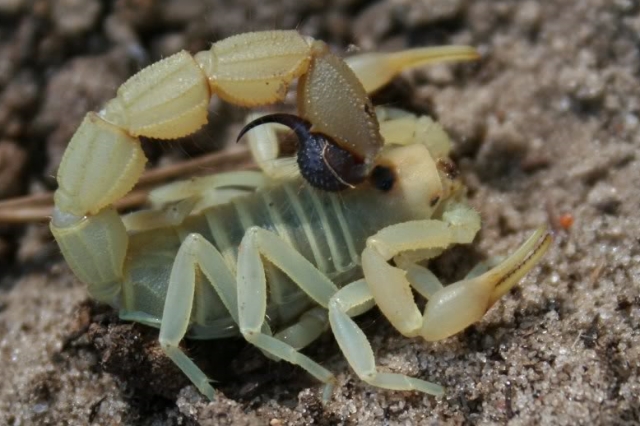 © General Gump
© General Gump
Light Morph, Botswana, Central Kalahari Game Reserve
Description
Parabuthus raudus a thick tail and thin pincers. This species reaches about 8-12 cm in bodysize (even up to 16 cm), males are smaller and less bulky than the females. It has a general yellow base coloration, where walking legs and pedipals are a bit lighter in color then the rest of the body. The yellow can diverge into more brown colors, in addition the metasomal segments III to V and the telson can be darker colored depending on the origin of the animal. As typical for Parabuthus, the pedipals of P. raudus are thin, whereas the metasoma is stick and heavily granulated. Adult males possess thicker, bulkier chelae than females.
Distribution
It occurs in the most Northern, Western part of South Africa into the Eastern side of Namibia, Western side of Botswana and in the North Western side of Zimbabwe.
Habitat
Found in the Kalahari sand system and in sandy areas at and around the Orange River. It digs tunnels in open land and in the vicinity of shrubs and pieces of gras.
Venom
Excitatory neurotoxins. Severe envenoming possible, potentially lethal. This species has been known to spray venom if provoked.
Family: Buthidae
 © General Gump
© General GumpLight Morph, Botswana, Central Kalahari Game Reserve
Description
Parabuthus raudus a thick tail and thin pincers. This species reaches about 8-12 cm in bodysize (even up to 16 cm), males are smaller and less bulky than the females. It has a general yellow base coloration, where walking legs and pedipals are a bit lighter in color then the rest of the body. The yellow can diverge into more brown colors, in addition the metasomal segments III to V and the telson can be darker colored depending on the origin of the animal. As typical for Parabuthus, the pedipals of P. raudus are thin, whereas the metasoma is stick and heavily granulated. Adult males possess thicker, bulkier chelae than females.
Distribution
It occurs in the most Northern, Western part of South Africa into the Eastern side of Namibia, Western side of Botswana and in the North Western side of Zimbabwe.
Habitat
Found in the Kalahari sand system and in sandy areas at and around the Orange River. It digs tunnels in open land and in the vicinity of shrubs and pieces of gras.
Venom
Excitatory neurotoxins. Severe envenoming possible, potentially lethal. This species has been known to spray venom if provoked.
Re: AW Arachnid Book: Scorpions - Photos & Descriptions
Transvaal Thick-tailed Scorpion Parabuthus transvaalicus
Family: Buthidae
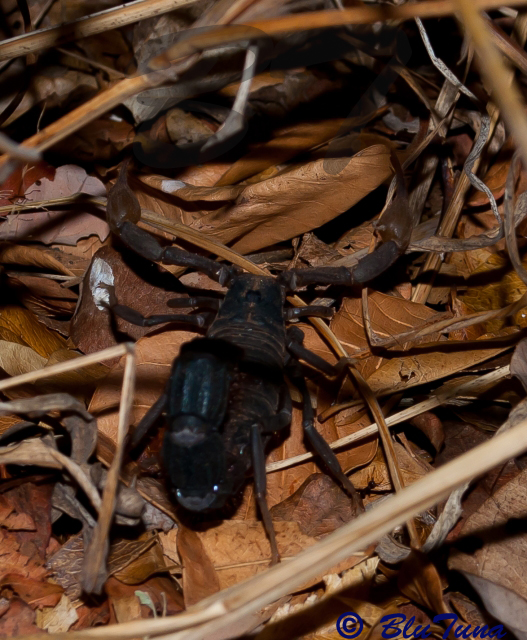 © BluTuna
© BluTuna
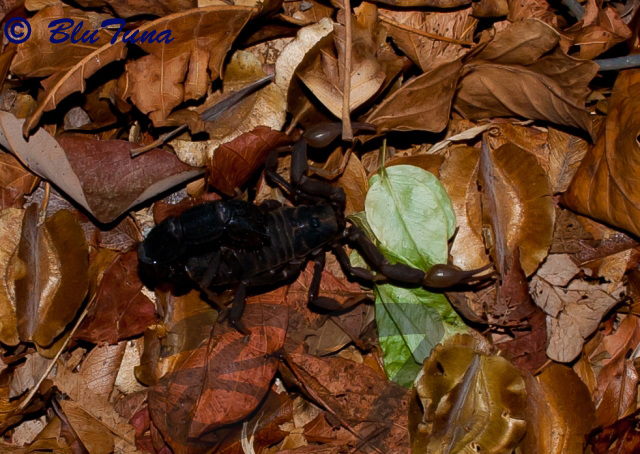 © BluTuna
© BluTuna
Kruger National Park, Balule camp
Description
The genus Parabuthus includes some of the largest scorpions, which are between 40 mm and 140 mm in length. They can be recognised by their small pincers and thick tails.
Parabuthus transvaalicus is one of the biggest scorpions in the family Buthidae, growing up to 140 mm in length. Parabuthus transvaalicus is able to produce a sound by scraping the sting across the ridges on the dorsal surface, an act known as stridulation and which is normally used as a warning sign to intruders.
It is dark brown to black in colour and has hair on some parts of its body. Its pincers are thin and red-brown, but its tail is thickened, with the sting segment being as wide as the rest of the tail. Pedipals and legs are lighter in color. A powerful cauda with numerous redish hairs. Small, slender pincers. No subacular tooth on telson.
Younglings resemble the adults at birth but are pale and under-developed. They have no exoskeleton, which only develops after the first moult, when the young scorpions attain an adult-like shape with a better and stronger exoskeleton. At this stage the young leave their mother and disperse.
Distribution
It is known to occur in South Africa, Zimbabwe, Swaziland, Mozambique and Botswana. In South Africa, it is found in Gauteng, KwaZulu-Natal and Limpopo Province.
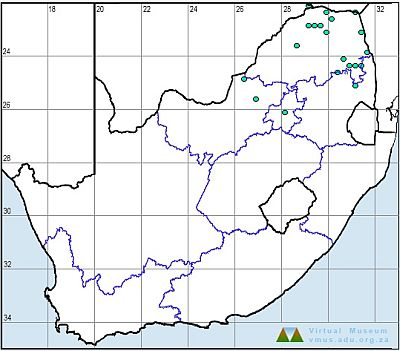
Habitat
Parabuthus transvaalicus is ground dwelling and burrows in sand, shrubs, under rocks and logs. It is nocturnal, resting in a shallow burrow under rocks during the day.
Diet
Scorpions, including P. transvaalicus, are predators that generally eat anything they can overpower. This includes insects, spiders, other scorpions, earthworms, gastropods, as well as small reptiles, mammals and amphibians.
Venom
Thick-tailed or fat-tailed scorpions generally have potent venom and P. transvaalicus is considered to be one of the most poisonous scorpions in southern Africa. It can also spray venom at a short distance. Its venom is neurotoxic and can be fatal to humans if left untreated. Children are more susceptible to the venom than adults. The venom can cause an allergic reaction, which, if extreme enough, might cause the victim to go into anaphylactic shock that can be fatal if not treated immediately.
Links: Biodiversity Explorer
Family: Buthidae
 © BluTuna
© BluTuna © BluTuna
© BluTunaKruger National Park, Balule camp
Description
The genus Parabuthus includes some of the largest scorpions, which are between 40 mm and 140 mm in length. They can be recognised by their small pincers and thick tails.
Parabuthus transvaalicus is one of the biggest scorpions in the family Buthidae, growing up to 140 mm in length. Parabuthus transvaalicus is able to produce a sound by scraping the sting across the ridges on the dorsal surface, an act known as stridulation and which is normally used as a warning sign to intruders.
It is dark brown to black in colour and has hair on some parts of its body. Its pincers are thin and red-brown, but its tail is thickened, with the sting segment being as wide as the rest of the tail. Pedipals and legs are lighter in color. A powerful cauda with numerous redish hairs. Small, slender pincers. No subacular tooth on telson.
Younglings resemble the adults at birth but are pale and under-developed. They have no exoskeleton, which only develops after the first moult, when the young scorpions attain an adult-like shape with a better and stronger exoskeleton. At this stage the young leave their mother and disperse.
Distribution
It is known to occur in South Africa, Zimbabwe, Swaziland, Mozambique and Botswana. In South Africa, it is found in Gauteng, KwaZulu-Natal and Limpopo Province.

Habitat
Parabuthus transvaalicus is ground dwelling and burrows in sand, shrubs, under rocks and logs. It is nocturnal, resting in a shallow burrow under rocks during the day.
Diet
Scorpions, including P. transvaalicus, are predators that generally eat anything they can overpower. This includes insects, spiders, other scorpions, earthworms, gastropods, as well as small reptiles, mammals and amphibians.
Venom
Thick-tailed or fat-tailed scorpions generally have potent venom and P. transvaalicus is considered to be one of the most poisonous scorpions in southern Africa. It can also spray venom at a short distance. Its venom is neurotoxic and can be fatal to humans if left untreated. Children are more susceptible to the venom than adults. The venom can cause an allergic reaction, which, if extreme enough, might cause the victim to go into anaphylactic shock that can be fatal if not treated immediately.
Links: Biodiversity Explorer
Re: AW Arachnid Book: Scorpions - Photos & Descriptions
Black Hairy Thick-tailed Scorpion Parabuthus villosus
Family: Buthidae
Description
Up to 180 mm long, the largest member of the family in the world. A very hairy scorpion, pitch black to brown with yellow legs depending on the location within its distribution. It is active during the day and is often seen in the late afternoon and early morning.
Males are smaller and more slender than females, and use their more bulbous pedipalps to grasp the female's pedipalps during courtship.
P. villosus is specially adapted for rocky habitats. This is evident in their flattened appearance and elongated appendages.
Within the genus Parabuthus, P. villosus can be diagnosed as follows: Caudal segment 4 with 10 strong granular keels. Ventral keels indistinct posteriorly on this segment. Tail narrowing posteriorly, caudal segment 4 narrower than 1 (rarely equal in width). Dorsal view of dorso-lateral keels subparallel. Stridulatory area on
caudal segment 1 broad, composed of strong granules, occasionally forming short ridges . Color of trunk blackish brown to black. Cauda usually pilose.
Distribution
Namibia (entire western region of the country including the Namib Desert, Fish River Canyon, Epupa Falls, Brandberg, Spitzkoppe, Swakopmund and Walvis Bay regions, Windhoek and the Orange River) and the northwestern Cape Province of South Africa.
Habitat
Found in rocky areas, in scrapes under surface debris such as rocks and logs and, on occasion, under the loose bark of fallen trees.
It constructs burrows under rocks and stones.
Diet
Insects, lizards, mice. All buthid scorpions have powerful neurotoxic venoms and kill or paralyse their prey by stinging them. Drinks fog water from the stems of plants, gathering droplets with it's claws.
Breeding
Litters numbering up to 32 are born in the summer months.
Venom
Parabuthus villosus has a fast-acting venom. A sting from this species could be life-threatening. When alarmed, it can, by whipping its tail back and forth, spray its venom which is toxic if squirted in the eyes.
Family: Buthidae
Description
Up to 180 mm long, the largest member of the family in the world. A very hairy scorpion, pitch black to brown with yellow legs depending on the location within its distribution. It is active during the day and is often seen in the late afternoon and early morning.
Males are smaller and more slender than females, and use their more bulbous pedipalps to grasp the female's pedipalps during courtship.
P. villosus is specially adapted for rocky habitats. This is evident in their flattened appearance and elongated appendages.
Within the genus Parabuthus, P. villosus can be diagnosed as follows: Caudal segment 4 with 10 strong granular keels. Ventral keels indistinct posteriorly on this segment. Tail narrowing posteriorly, caudal segment 4 narrower than 1 (rarely equal in width). Dorsal view of dorso-lateral keels subparallel. Stridulatory area on
caudal segment 1 broad, composed of strong granules, occasionally forming short ridges . Color of trunk blackish brown to black. Cauda usually pilose.
Distribution
Namibia (entire western region of the country including the Namib Desert, Fish River Canyon, Epupa Falls, Brandberg, Spitzkoppe, Swakopmund and Walvis Bay regions, Windhoek and the Orange River) and the northwestern Cape Province of South Africa.
Habitat
Found in rocky areas, in scrapes under surface debris such as rocks and logs and, on occasion, under the loose bark of fallen trees.
It constructs burrows under rocks and stones.
Diet
Insects, lizards, mice. All buthid scorpions have powerful neurotoxic venoms and kill or paralyse their prey by stinging them. Drinks fog water from the stems of plants, gathering droplets with it's claws.
Breeding
Litters numbering up to 32 are born in the summer months.
Venom
Parabuthus villosus has a fast-acting venom. A sting from this species could be life-threatening. When alarmed, it can, by whipping its tail back and forth, spray its venom which is toxic if squirted in the eyes.
-
Klipspringer
- Global Moderator
- Posts: 5862
- Joined: Sat Sep 14, 2013 12:34 pm
- Country: Germany
- Contact:
Re: AW Arachnid Book: Scorpions - Photos & Descriptions
Highveld Lesser-Thicktail Uroplectes triangulifer
Family: Buthidae
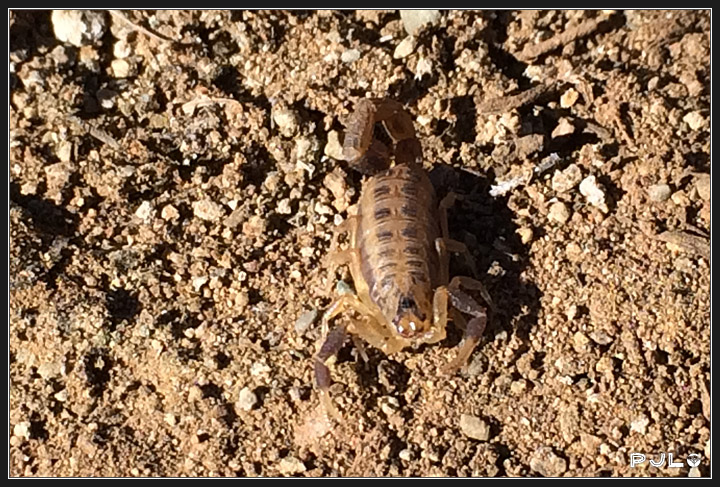 © PJL
© PJL
Mountain Zebra National Park
Description
A small orange to yellow scorpion under 5 cm with the tail extended. Its colouration varies slightly depending on its location. It is characterized by two dark bands that depending on locality has one orange band down the centre and sometimes has two orange bands along the sides of the tergites ("back"). The last two segments of the yellow tail are particularly dark in colouration. The arms are usually dark with yellow pincers. Can occur in a dark black/blue variation with red legs, often in high altitude areas of Mpumalanga.
Distribution
Uroplectes triangulifer has quite a wide distribution, found mostly in the Eastern part of South Africa, as far North as the border of Zimbabwe and as far South as Port Elizabeth. Probably one of the most common scorpion species in South Africa.
Habitat
Uroplectes triangulifer can be found under rocks and debris usually on hard soils. It is also active on warm nights.
Venom
The sting of this species may cause pain but is not medically important.
Links:
https://scorpionsalive.co.za/uroplectes_species.htm
Family: Buthidae
 © PJL
© PJLMountain Zebra National Park
Description
A small orange to yellow scorpion under 5 cm with the tail extended. Its colouration varies slightly depending on its location. It is characterized by two dark bands that depending on locality has one orange band down the centre and sometimes has two orange bands along the sides of the tergites ("back"). The last two segments of the yellow tail are particularly dark in colouration. The arms are usually dark with yellow pincers. Can occur in a dark black/blue variation with red legs, often in high altitude areas of Mpumalanga.
Distribution
Uroplectes triangulifer has quite a wide distribution, found mostly in the Eastern part of South Africa, as far North as the border of Zimbabwe and as far South as Port Elizabeth. Probably one of the most common scorpion species in South Africa.
Habitat
Uroplectes triangulifer can be found under rocks and debris usually on hard soils. It is also active on warm nights.
Venom
The sting of this species may cause pain but is not medically important.
Links:
https://scorpionsalive.co.za/uroplectes_species.htm


